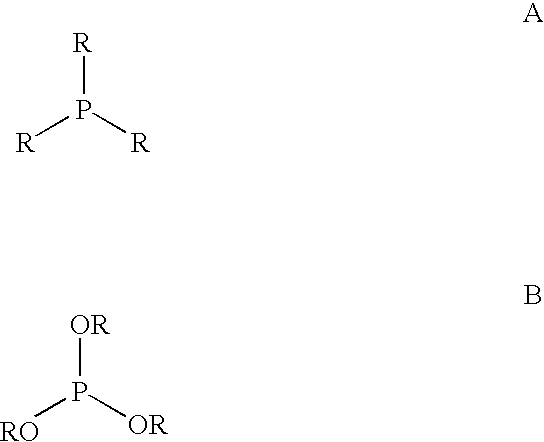Supported bis(phosphorus) ligands and their use in the catalysis
- Summary
- Abstract
- Description
- Claims
- Application Information
AI Technical Summary
Benefits of technology
Problems solved by technology
Method used
Image
Examples
example 1
Grafting 3,3′-Diisopropyl-6,6′-Dimethyl-2,2′-Biphenol onto Merrifield Resin
[0097]
[0098]A mixture of 3,3′-diisopropyl-6,6′-dimethyl-2,2′-biphenol (1.0 g), Merrifield resin (1.0 g, 1.9 mmol Cl), ZnCl2 (0.2 g) and 1,2-dichloroethane (6 mL) was stirred at over night and 70° C. for 4 days. The solid was filtered, washed with hexanes (2×10 mL) and methanol (3×10 mL), dried on full vacuum to give a solid (1.28 g).
example 1a
Preparation Polymer-Supported Ligand (SL 1) from the Reaction of 3,3′-diisopropyl-6,6′-dimethyl-2,2′-biphenol Grafted Merrifield Resin and Di(2-isopropylphenyl) Phosphorochloridite
[0099]
[0100]A mixture of the polymer (0.5 g) from example 1 and di(2-isopropylphenyl) phosphorochloridite (1.0 g) was stirred in about 20 mL of tetrahydrofuran (THF) for 30 min. Tri-n-butylamine (1.0 g) was added to the mixture. The resulting mixture was stirred at room temperature for 4 days. The solid was collected by filtration and washed with acetonitrile (2×20 mL), and vacuum dried to give 0.7 g of the ligand.
[0101]Elemental analysis: P % 2.4.
example 2
Grafting 3,3′6,6′-Tetramethyl-5,5′-diisopropyl-2,2′-biphenol onto Merrifield Resin
[0102]
[0103]A mixture of 3,3′6,6′-tetramethyl-5,5′-diisopropyl-2,2′-biphenol (0.7 g), Merrifield resin (0.5 g, 0.95 mmol Cl), AlCl3 (50 mg) and 1,2-dichloroethane (6.5 g) was stirred at room temperature for 3 days and 70° C. for 2 hours. The solid was filtered, washed with hexanes (2×30 mL) and methanol (3×30 mL), dried on full vacuum to give a solid (0.64 g).
PUM
| Property | Measurement | Unit |
|---|---|---|
| Fraction | aaaaa | aaaaa |
| Fraction | aaaaa | aaaaa |
| Fraction | aaaaa | aaaaa |
Abstract
Description
Claims
Application Information
 Login to View More
Login to View More - R&D
- Intellectual Property
- Life Sciences
- Materials
- Tech Scout
- Unparalleled Data Quality
- Higher Quality Content
- 60% Fewer Hallucinations
Browse by: Latest US Patents, China's latest patents, Technical Efficacy Thesaurus, Application Domain, Technology Topic, Popular Technical Reports.
© 2025 PatSnap. All rights reserved.Legal|Privacy policy|Modern Slavery Act Transparency Statement|Sitemap|About US| Contact US: help@patsnap.com



